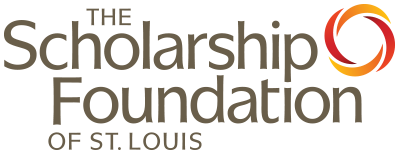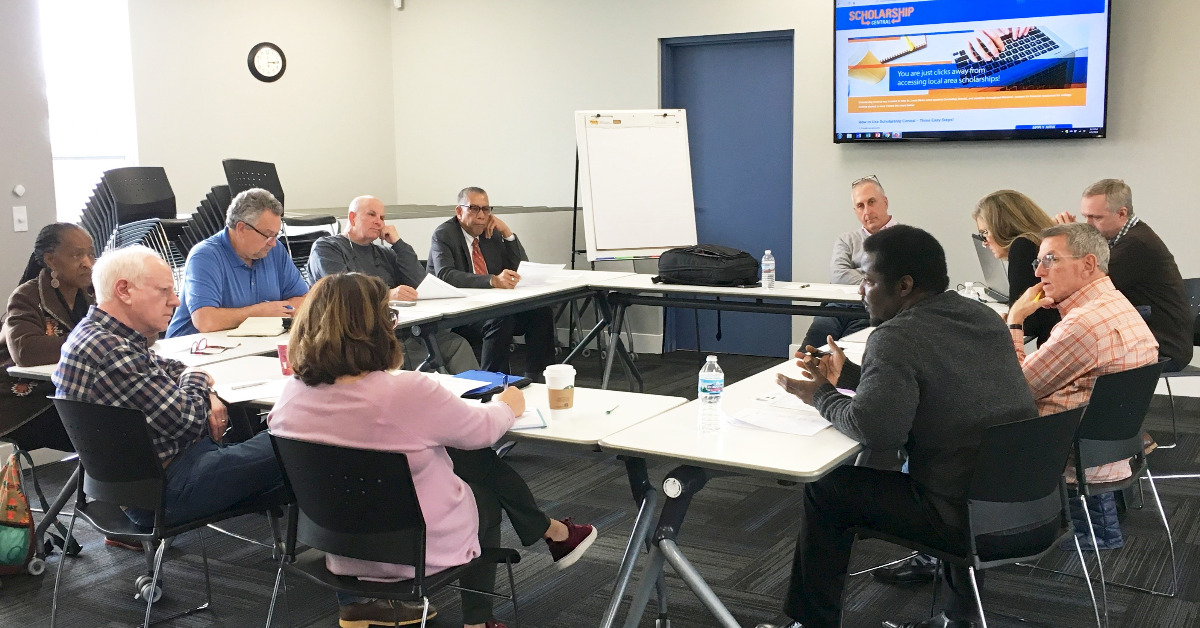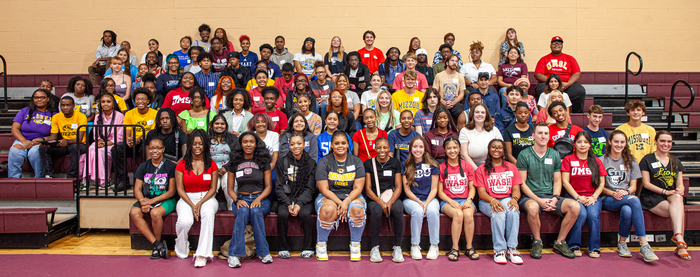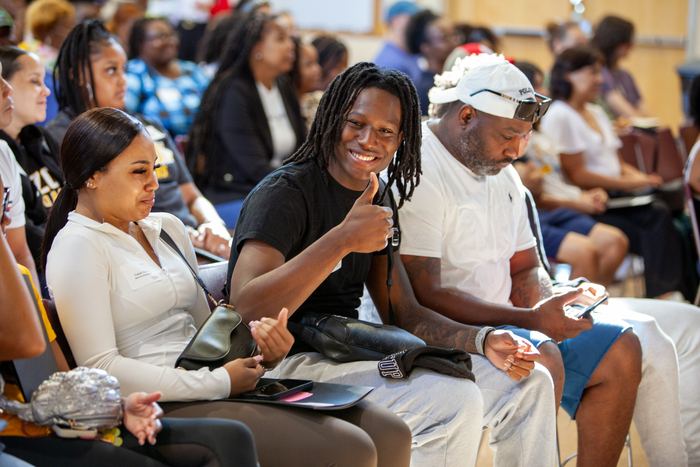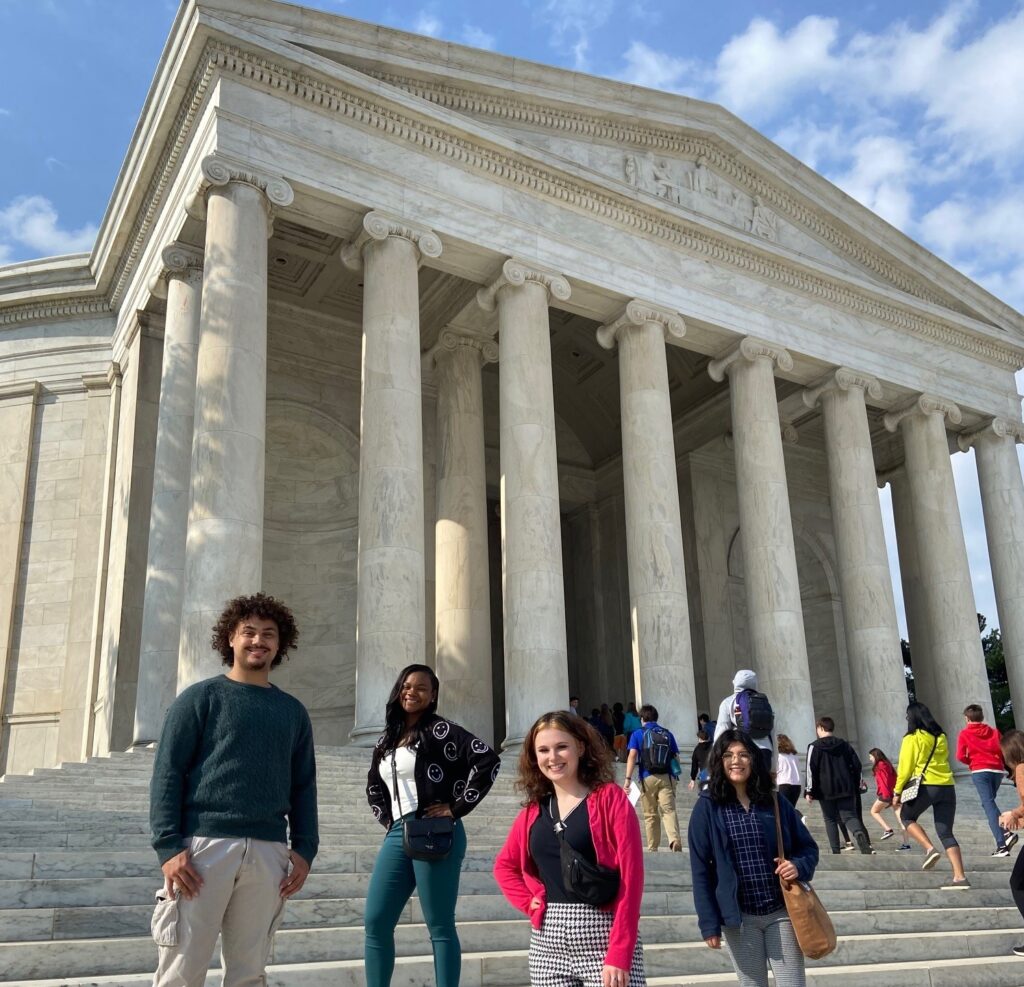
Program Manager Thurman Young convening board members to discuss application review and awards in 2018.
As many readers will know, it was with an interest-free loan that The Scholarship Foundation of St. Louis began in 1920 and the loan program was the primary way the Foundation supported students for the first 99 years of our history. In 2023, we project The Scholarship Foundation will award just under $7 million to 620 students. Fully 75% of those awards will be made in the form of scholarship grants, the balance in interest-free loans.
Scholarship grants have surpassed loans in total dollars and numbers of awards for three years now (2020, 2021, and 2022). Some have expressed concern that grants have somehow diminished the loan program, but the situation is more complex than that.
Our mission is constant; our methods have had to change.
SCHOLARSHIP GRANTS ARE GROWING, LOANS ARE NOT

In 1994, board members Bente Seitz, Karen Berry Elbert, Regina Edwards, and Audrey Shanfeld gathered to discuss interest-free loan selection criteria.
Is this a good thing? It depends. If you ask a student, their response will be very clear and direct (they may look at you as if you’re crazy to even inquire). If you ask a guidance counselor or teacher or parent, it is likely they too will understand this to be a sign of success, given the headlines they’ve read about ongoing confusion surrounding federal student loans. If you ask a longtime Scholarship Foundation donor, former board member, and some current board members, you’ll get reactions that range from celebration to concern.
HOW DID WE GET HERE?
We got here knowingly, not suddenly. We are tracking against our strategic plans of the last ten years, and we are right where we are supposed to be. We reached this point rooted in our mission and values and responding as best we can to circumstances not of our making.
Values
Since 1920, every piece of correspondence and every annual report of The Scholarship Foundation presents a “students first” ethos. And by this, the Foundation has always meant to point toward those students who are left out, priced out, excluded by one means or another from higher education by factors beyond their control.
Our founding and persistent goal is not to “make loans.” It is to advance higher education, support degree completion, and build strong communities that strengthen democracy.
Environmental factors
Our decisions about programs and finances can’t be made by looking only inward. For a long time now (at least since fundamental changes to higher education financing began in the early 1980s), we can’t do it alone. We work alongside state, federal, and school financial aid policy and programs.
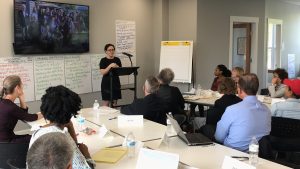
Upon repaying her loan in full in 2018, Stacy Massey met with the board to describe the impact of borrowing on her educational decisions.
At our founding and in the early decades, our foremothers understood that the burden students were undertaking with interest-free loans could be repaid after graduation without causing undue financial strain. But the world has changed around us. Total cost for college has far outpaced income. The interest-free loan now rarely covers the whole cost. For our students today, covering the whole cost of attendance would mean loaning each an average of $27,000 annually. Given funds available for loans, such a strategy would reduce the number of students we could have funded in 2021 from 489 to 178. A total debt in excess of $100,000 for four years of college is unmanageable for most of the students we support.
In more recent decades we have learned (as has the whole nation) that expanding access to higher education has not reduced inequity. So many systems intersect to result in discrimination on the basis of race and economic class in post-secondary education. State, federal, and school financial support to students continues to be inequitably determined and distributed. Students who are low-income and those who are Black or Brown face greater academic hurdles, accumulate much more debt and are more likely to leave school without graduating because they are not properly supported financially or otherwise by systems that are not built to serve them.
WE SAW THIS COMING
Three important policies, ratified by the board of directors in late 2015, are clues to our current position:
- Our awards (interest-free loan, grant, or both) will be “last dollar”. This is simple math. Any gap remaining after family contribution and grants from other sources are applied must be filled by our award. If not, we won’t make an award at all. We don’t look the other way, sending a student to school underfunded.
- An interest-free loan from us will be the only student loan our students incur. With a maximum of $11,000 per year, our interest-free loan program should meet the remaining gap. If it can’t and the student must borrow more elsewhere, we believe that is too much debt. We guard against students borrowing too much, tapping multiple lenders, and committing to unfavorable loan terms.
- Grants are awarded first and in maximum amounts before interest-free loans are awarded. This is in the best interest of the student and honors the impact the donors of scholarship grants seek to have.
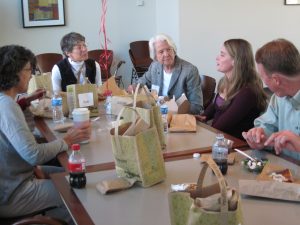
Board members invited students to a 2013 board retreat to better understand the issues they faced. Left to right: Ellen Schapiro, Susan Lipstein, Estie Pruett, Stephanie Seligman, and James Boldt.
A clear and thoughtful path has been established through the three strategic plans of the last decade. Each plan has included affirmation of mission and vision, environmental scan, and internal financial and program review. Scholarship Foundation strategic planning engages the entire board and staff in preparation and deliberations over a full Saturday. A written plan is presented several months later and ratified by the full board after action plans have been drafted board committees and staff. Annual work plans are then informed and directed by strategy set in the plans.
2015-2018
The board voted to “revisit our financial aid strategy to better accommodate market needs (likely resulting in a shift toward more grants vs. loans)”. This plan called for review of award structure and directed deeper cost analysis. The plan envisioned that outcomes would be “fewer students borrow inappropriately” and “students are more capable of doing their own debt analysis.” The plan forecasted that by 2018 grants would be 15-25% of total awards and cautioned that loan parameters should remain consistent.
2019-2020 Strategic Plan
Thoroughly researched, the strategic plan voted by the board in 2019 did not anticipate worldwide pandemic or foretell the academic and economic aftermath. The plan set a goal that Scholarship Foundation students “graduate with a debt load at or below the average debt load of all college graduates who borrow”. Further, the plan called for more research on the optimal mix of loans and grants, considering both students and sustainability. In addition, the plan directed effort toward increasing contributed revenue restricted for student grant programs, advising, and advocacy.
2021-2025 Strategic Plan
Nearing the close of a full year affected by COVID, the full board and staff met to revisit the strategic plan and recalibrate for then current conditions. That revised plan, under which we are now working, calls for restoring the number of students funded to pre-pandemic levels while increasing the total grant dollars (for cost of attendance and for microgrants) awarded each year. It further directs that graduates’ debt load remain at or below the average debt load of all college graduates who borrow.
WHERE ARE WE GOING?
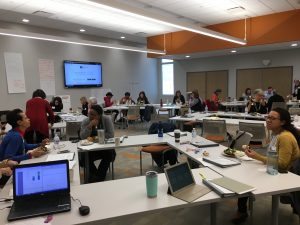
Board and staff met for a full day retreat in 2018 to review programs and set strategy for future loans, grants, and support services.
At the start of 2023 and mid-way through our current strategic plan, we can report:
- The national average for total debt among all students who graduate with a bachelor’s degree is $29,000. In 2020 and 2021 the averages among our graduates were $23,773 and $22,407, respectively.
- In the last five years, contributed funds for scholarship grants have increased from $880,508 annually to $2.9 million. The Foundation has received a total of $14.2 million dollars to fund scholarship grants to students since 2017. Funds contributed for scholarship grants have more than tripled in five years.
- In 2021, the Foundation awarded 236 interest-free loans and 332 scholarship grants to a total of 489 students (79 students received both loan and grant and could not have been fully funded without the grant program).
The interest-free loan program has remained constant in purpose. Our repayment program has been entirely restructured from a “one size fits all” to a plan that is much more responsive to individual circumstance. We have improved operations by hiring a full-time repayment manager, building a new online management system with a borrower portal, and cleaning-up the backlog of dormant and delinquent accounts from prior years.
We have been blessed and challenged by contributions made toward new and expanded scholarship programs over the last decade, with more in development now. By definition, each program is multi-year (in donor commitment and in student benefit) and governed by the policies for eligibility and selection set by our board of directors. The larger of the programs also include contributed funds directed to outreach and student support services, an essential part of our program. Much time and effort are required with potential funding organizations to understand the value of our unique commitment to students – including our wrap-around support – for the duration of their educational pursuit. That effort has, we believe, changed scholarship grantmaking in our metropolitan area.
A TRUE CONFESSION
These have been especially trying times. In reading back through the prior strategic plans, it is striking how we have closed 2022 exactly where we said we wanted to be. We can be proud that the Foundation has so much more to offer students in loans, grants, and the oft essential combination of the two. The either/or nature of the loan or grant debate is tiring and can feel counter-productive to raising the funds and maintaining the momentum that has kept us on course.
But you know what? I am vastly encouraged to be a part of a community of learners who ask questions, look for evidence, are not satisfied with status quo or easy answers. I am grateful that our students, donors, current and former board members and staff are thinking aloud and together, complicated as that can be. I am overjoyed by the commitment the St. Louis community has shown to funding our students fully. I don’t have to look too far to know why we do what we do, and how important it is to a world in need.
I hope the same is true for you. Happy new year!
– Faith Sandler
